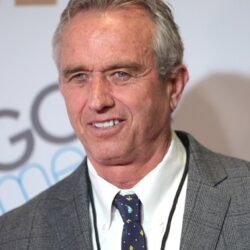 News
News Presidential Elections and Party Unity

When push came to shove, Harry S Truman endorsed his party’s choice for president in 1960, John Kennedy. (Photo: Harry S. Truman Library & Museum)
As we head toward the 2016 nominating conventions, both presumptive nominees Republican Donald Trump and Democrat Hillary Clinton face questions about their ability to unify their parties around their candidacies, both at the political elite level and the grass roots level.

Howard J. Silver served for a quarter century as the executive director of the Consortium of Social Sciences Agencies. His blog appears monthly at Social Science Space.
The most vivid example of party disunity remains the split in the Republican Party in 1912 that led former President Theodore Roosevelt to break with then incumbent President William Howard Taft and to run under the Progressive Party banner. Roosevelt finished second to Woodrow Wilson, who took advantage of the GOP split to get elected president.
In 1924, the 103-ballot Democratic convention that produced West Virginia lawyer John Davis as the nominee, sent many urban progressive Democrats into the arms of that year’s Progressive Party candidate, Senator Robert La Follette Sr. of Wisconsin, who would get almost 17 percent of the national vote compared to Davis’ 29 percent. Davis would win 12 states to La Follette’s one (Wisconsin) as Calvin Coolidge swept to victory.
Twenty-four years later, a civil rights plank in the platform led Southerners to walk out of the Democratic convention to nominate then-South Carolina governor Strom Thurmond as the candidate of the States’ Rights Democrat Party. That same year the left wing of the party also abandoned the Democrats and nominated Henry Wallace of Iowa, Franklin Roosevelt’s vice president from 1941-45, as the Progressive Party’s leader. Truman – FDR’s fourth-term vice president — surprised almost everyone by winning this four-way contest with almost 50 percent of the vote.
In 1960, within his party, Republican Richard Nixon initially had to deal with the threats of New York Governor Nelson Rockefeller and his demands for concessions on the platform. Once they were granted in the famous “Midnight Meeting” at Rockefeller’s apartment on Fifth Avenue, Nixon had problems with conservatives, who would take over the party four years later, for giving in to Rockefeller. Once into the campaign, Nixon had to deal with President Eisenhower’s response to a reporter’s question about Nixon’s contributions during his tenure as vice president. Ike responded: “If you give me a week, I might think of one.” In the end, Eisenhower would spend the final weeks of the campaign boosting Nixon, which helped keep the GOP together for a very close popular vote result. For Kennedy the problem was the South, where presidential electors in Mississippi and Alabama cast 14 electoral votes for Senator Harry Byrd of Virginia.
In 1964, the Republicans, and in 1972, the Democrats, nominated Presidential candidates representing the ideological wings of both parties. Arizona Senator Barry Goldwater’s extremism cost him 20 percent of the GOP vote and his rivals for the nomination – Nelson Rockefeller, Pennsylvania Governor William Scranton, and former Ambassador to Vietnam and 1960 GOP Vice Presidential nominee Henry Cabot Lodge – stayed far away from Goldwater’s campaign.
For South Dakota Senator George McGovern, the Democratic candidate in 1972, things got worse. About one-third of Democrats deserted him and voted for Richard Nixon’s re-election. One of Nixon’s TV ads showed a hand sweeping troops and weapons off a table, representing McGovern’s dovish stands on the Vietnam War and national defense. For Democrats who had supported the war as well as a strong national defense during the Cold War, it was easy for them to defect; with many saying, “I didn’t leave the Democratic Party; it left me.” Some of these folks would be called neo-conservatives and have a strong role in GOP defense policy up to the present time.
In the 1968 election between these two, the presence of Alabama Governor George Wallace as the candidate of the American Independent Party provided more evidence about the validity of President Johnson’s prediction that his championing the Civil Rights Act of 1964 and the Voting Rights Act of 1965 would keep the South Republican for many years. Southern Democrats, many of whom had already voted Republican in 1964, now had a home-grown champion. Wallace would get almost nine million votes and carry five Southern states (Alabama, Arkansas, Georgia, Louisiana and Mississippi).
That same year, the Democratic nominee, LBJ’s Vice President Hubert Humphrey, confronted the difficulty of uniting a party that had seen two candidates, Minnesota Senator Eugene McCarthy and New York Senator Robert Kennedy, challenge its incumbent president. Humphrey also had the difficult task of trying to woo the anti-Vietnam War Democrats without alienating President Johnson’s supporters. It was a problem that the nominee only succeeded in overcoming toward the end of the campaign, which made the final popular vote much closer than many had thought – 43.4 percent for Nixon, 42.7 percent for Humphrey.
In 1980, Jimmy Carter running for re-election in the midst of the Iran Hostage Crisis and facing a challenge to his re-nomination from Massachusetts Senator Edward Kennedy would lose about one-quarter of the Democratic electorate to his opponent Ronald Reagan. Many of these became the Reagan Democrats, the white working-class Northerners and Midwesterners who abandoned their party in 1980 and again when Reagan ran for re-election in 1984.
After 1984 defectors from party voting for president decreased significantly. The exception was 1992 when Ross Perot ran as an independent. In June 1992, he was actually ahead in the polls over both Incumbent George H.W. Bush and Arkansas Governor Bill Clinton. In November, Perot would get over 19 million votes, almost 19 percent of the total. Yet, he would win no states and no electoral votes. According to Gallup, he would get 16 percent of those considered Republicans and 10 percent of those who called themselves Democrats. Perot would run again in 1996, with much less success.
In the last four presidential elections, George W. Bush’s two wins and Barack Obama’s two wins, the enhanced partisanship so evident throughout the United States and in Washington has led to far less crossing of party lines. According to Gallup, Bush won 92 percent of the GOP vote in 2000 and 95 percent in 2004. Obama won 93 percent of the Democrats in 2008 and 95 percent in 2012. Former Massachusetts Governor Mitt Romney received 97 percent of the GOP vote in 2012.
With five months to go in the 2016 presidential election both presumptive nominees, who at the moment have unusually high unfavorable ratings, have their work to do. Opposition to Hillary Clinton has been a rallying point for Republicans for almost 25 years. Can this antipathy trump (pun intended) Republicans’ problems with their own standard bearer. Donald Trump’s campaign for the nomination, which included a number of ludicrous pronouncements, gives the Democrats much fodder for unification. Yet, the campaign by Vermont Senator Bernie Sanders provides Clinton with a challenge in bringing all Democrats back into the fold.
Where are we headed – and what might the results portend for the social science community? In a presidential campaign that has made American history with one party’s nominee and where a non-politician who surprised pundits and the establishment emerged as the nominee of the other party, nothing is certain.




























































































